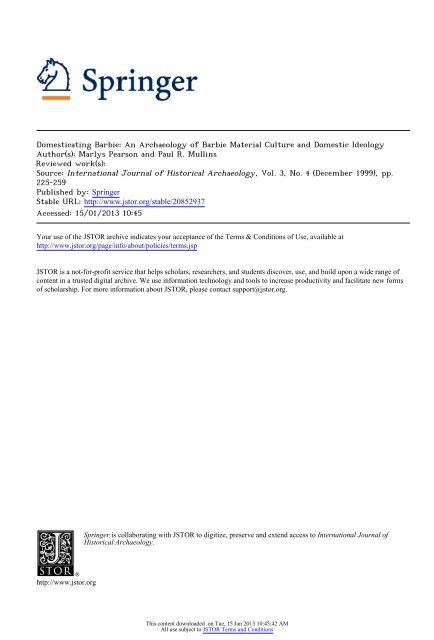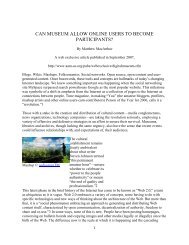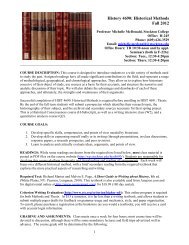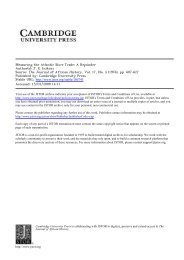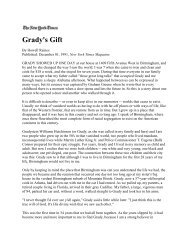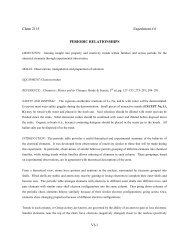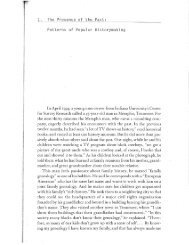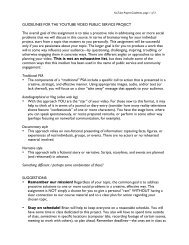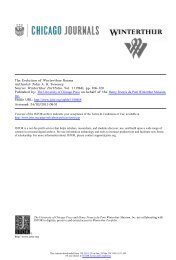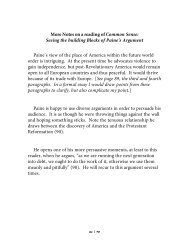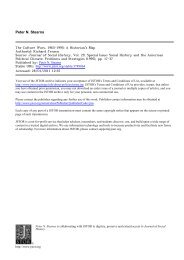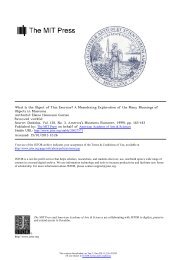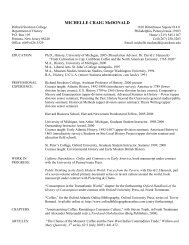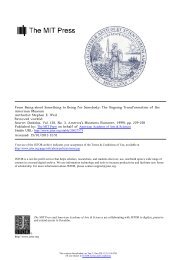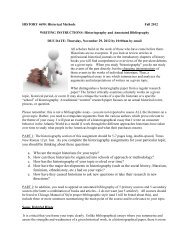Domesticating Barbie - Richard Stockton College Word Press ...
Domesticating Barbie - Richard Stockton College Word Press ...
Domesticating Barbie - Richard Stockton College Word Press ...
Create successful ePaper yourself
Turn your PDF publications into a flip-book with our unique Google optimized e-Paper software.
<strong>Domesticating</strong> <strong>Barbie</strong>: An Archaeology of <strong>Barbie</strong> Material Culture and Domestic Ideology<br />
Author(s): Marlys Pearson and Paul R. Mullins<br />
Reviewed work(s):<br />
Source: International Journal of Historical Archaeology, Vol. 3, No. 4 (December 1999), pp.<br />
225-259<br />
Published by: Springer<br />
Stable URL: http://www.jstor.org/stable/20852937 .<br />
Accessed: 15/01/2013 10:45<br />
Your use of the JSTOR archive indicates your acceptance of the Terms & Conditions of Use, available at .<br />
http://www.jstor.org/page/info/about/policies/terms.jsp<br />
.<br />
JSTOR is a not-for-profit service that helps scholars, researchers, and students discover, use, and build upon a wide range of<br />
content in a trusted digital archive. We use information technology and tools to increase productivity and facilitate new forms<br />
of scholarship. For more information about JSTOR, please contact support@jstor.org.<br />
.<br />
http://www.jstor.org<br />
Springer is collaborating with JSTOR to digitize, preserve and extend access to International Journal of<br />
Historical Archaeology.<br />
This content downloaded on Tue, 15 Jan 2013 10:45:42 AM<br />
All use subject to JSTOR Terms and Conditions
International Journal ofHistorical Archaeology\ Vb/..?, No. 4, 1999<br />
<strong>Domesticating</strong> <strong>Barbie</strong>: An Archaeology of <strong>Barbie</strong><br />
Material Culture and Domestic Ideology<br />
Mariys<br />
Pearson1 and Paul R. MuIIins2<br />
A systematic examination of <strong>Barbie</strong> fashions, accessories, and playsets produced<br />
since 1959 reveals several distinct phases in the domestic symbolism associated<br />
with <strong>Barbie</strong>. Today, <strong>Barbie</strong> grocery shops, cleans house, cares for her young sib<br />
lings, and assumes careers which fill nurturing and protective roles like those<br />
championed in traditional domestic ideology. Yet in the late 1950s, <strong>Barbie</strong> was con<br />
ceived and marketed as a single career girl who did not do "rough housework.1*<br />
This paper examines the range of clothing and accessories marketed alongside<br />
<strong>Barbie</strong> as a mechanism to trace the changes in <strong>Barbie</strong>'s domestic image over<br />
nearly 40 years.<br />
KEY WORDS: <strong>Barbie</strong>; domesticity; toys; gender.<br />
"GIRLS CAN DO ANYTHING": BARBIE SYMBOLISM<br />
<strong>Barbie</strong> discourses ranging from academic analyses to popular media commen<br />
taries envision a remarkably wide range of symbolism in the world's top-selling<br />
toy. The most common tendency of <strong>Barbie</strong> analysts is to hyperbolize the doll's<br />
social symbolism, variously imagining<br />
a ditzy hedonistic consumer, a<br />
hypersex<br />
ualized bimbo, a<br />
subjugated homebody,<br />
or an utterly independent<br />
woman who<br />
demonstrates that "girls can do anything." Such caricatures make a variety of au<br />
thoritative claims to capture the essential nature of the doll's symbolism, but none<br />
can condense the diverse spectrum of contradictory <strong>Barbie</strong> meanings. Since 1959<br />
the doll's producers at Mattel always have attempted to circumscribe <strong>Barbie</strong>'s<br />
symbolic possibilities through a series of often-contradictory maneuvers, such as<br />
simultaneously deemphasizing and tacitly exploiting her sexuality, resisting as<br />
1<br />
Department of Anthropology, University of Massachusetts, Amherst, Massachusetts 01003.<br />
2Department of Anthropology, Indiana University-Purdue University Indianapolis, Cavanaugh Hall<br />
413, Indianapolis, Indiana 46202.<br />
225<br />
1092-7697/99/O90O-0225S 16.00/0? 1999 Plenum Publishing Corporation<br />
This content downloaded on Tue, 15 Jan 2013 10:45:42 AM<br />
All use subject to JSTOR Terms and Conditions
226 Pearson and Mullins<br />
well as coopting feminist broadsides, and celebrating <strong>Barbie</strong>'s social significance<br />
while they attack a variety of musicians, artists, and writers who subversively<br />
exploit the doll's symbolic ambiguities (cf. Avasthi, 1997; Rand, 1995). Despite<br />
Mattel's fevered efforts, <strong>Barbie</strong> meanings encompass a vast range of gendered,<br />
material, and social possibilities which often depart significantly from the party<br />
line.<br />
Perhaps the most problematic barrier to such interpretation of <strong>Barbie</strong> is the<br />
relative absence of systematic material analysis of the flood of dolls, clothing, and<br />
accessories which compose the <strong>Barbie</strong> universe. Popular and academic commenta<br />
tors alike routinely lapse into apocryphal observations of a few isolated accessories<br />
or a<br />
single physical attribute of the doll (e.g., hair, breasts), using this indiscrimi<br />
nate inspection<br />
as the tenuous foundation from which they can assail, celebrate, or<br />
ridicule <strong>Barbie</strong> symbolism along any number of agendas. Despite some quite co<br />
gent and perceptive insight into <strong>Barbie</strong>'s complex social symbolism, there remains<br />
little structured analysis which systematically relates the doll's social symbolism<br />
to the material variation among the thousands of <strong>Barbie</strong> products manufactured<br />
since 1959.<br />
We do not intend to ignore that <strong>Barbie</strong>'s ultimate social meaning is a com<br />
plex consequence of myriad competing visions which cannot be fully appreciated<br />
simply by examining <strong>Barbie</strong> material culture. A rigorous ethnography of the doll's<br />
consumers and the contexts in which <strong>Barbie</strong>s have been consumed would be nec<br />
essary to a critical anthropological interpretation of <strong>Barbie</strong>. An essential element<br />
of such an ethnography, though, should be a material analysis of <strong>Barbie</strong> clothes<br />
and accessories. In this sense, our "archaeology" of <strong>Barbie</strong> embrances the standard<br />
archaeological understanding of structured material description, identification of<br />
materials patterns, and anthropological analysis of the relationship between those<br />
patterns and their cultural and historical context. At the same time, we<br />
approach<br />
ar<br />
chaeological insight as a distinctive perspective which focuses on the rich variation<br />
and contradiction in material meanings. This is akin to Michel Foucault's (1972,<br />
pp. 138-140) notion of an<br />
archaeology which approaches meaning<br />
as<br />
metaphorical<br />
"layers" whose contradictory symbolism forms what he calls "spaces of dissen<br />
sion" (Foucault, 1972, p. 152; cf. Tilley, 1990, pp. 305-307). Such "spaces of<br />
dissension" are illuminated by objects like <strong>Barbie</strong> material culture whose symbol<br />
ism is always contested.<br />
Our advocacy of archaeological insight in this study has two basic implica<br />
tions. First, the flood of <strong>Barbie</strong> analysis in academic and popular literature makes<br />
little or no effort to understand <strong>Barbie</strong> material culture as a contiguous assemblage<br />
produced, consumed, and given meaning within a clearly defined sociohistorical<br />
context. Archaeologists would never consider analyzing a single object in isolation<br />
from related objects in the same assemblage or without reference to the interests of<br />
its producers or consumption context; <strong>Barbie</strong> commentators, though, routinely se<br />
lect a<br />
single accessory to buttress various interpretive claims. We are not<br />
suggesting<br />
that archaeological method is "objective" and inevitably will converge on <strong>Barbie</strong>'s<br />
This content downloaded on Tue, 15 Jan 2013 10:45:42 AM<br />
All use subject to JSTOR Terms and Conditions
<strong>Domesticating</strong> <strong>Barbie</strong> 227<br />
"authentic" essence. We do believe, however, that a systematic identification of all<br />
the elements of the <strong>Barbie</strong> universe provides a far more substantial foundation for<br />
interpretation than idiosyncratic insight or educated guesswork. <strong>Barbie</strong> provides<br />
a mirror of ourselves and society in the same way any commodity does: it is an<br />
alluring albeit idealized reflection which obliquely addresses social contradictions<br />
but evades or appears to resolve their most profound incongruities. To appreciate<br />
the complexity of this mirror, it is essential to acknowledge the specific range of<br />
options in <strong>Barbie</strong> material culture and probe how those options relate to broader<br />
social context.<br />
A second implication of turning archaeological eyes on <strong>Barbie</strong> is archaeol<br />
ogy's potential to advance our understanding of the present. A class of modern<br />
goods like <strong>Barbie</strong> material culture should demonstrate archaeology's capacity to<br />
interpret everyday life's most basic yet unexamined social and symbolic struc<br />
tures. As William Rathje's Garbage Project demonstrates, an archaeology which<br />
probes the difference between our perceptions of the material world and the actual<br />
patterns in that world can contemplate and perhaps transform the contradictions<br />
in our everyday lives (Rathje and Murphy, 1992; cf. Shanks and Tilley, 1987,<br />
pp. 172-173). Mattel argues that the standardized range of <strong>Barbie</strong>s sold in over<br />
70 countries and to consumers of every background in the United States simply pro<br />
vides "play options" with no relationship to consumer subjectivity (Westenhouser,<br />
1994, p. 119). Yet <strong>Barbie</strong> is not simply a sort of postmodern blank slate which can<br />
symbolize anything to any consumer: instead, <strong>Barbie</strong> material culture opens up a<br />
circumscribed range of possible meanings on a series of relatively well-defined<br />
but contested subjects. The doll's social meanings are a dynamic product of, on<br />
one hand, the symbolic possibilities which its producers "encode" in <strong>Barbie</strong> (via,<br />
for instance, body form, clothing, and advertising) and, on the other hand, con<br />
sumers' embrace, modification, subversion, and rejection of dominant ideologies<br />
and Mattel's intended <strong>Barbie</strong> meanings. Archaeological analysis offers a mech<br />
anism to link the doll's material style, seemingly disconnected ideologies, and<br />
consumers's negotiation of and resistance to those ideologies.<br />
We approached <strong>Barbie</strong> material culture in the same way we would archae<br />
ologically examine any class of material objects. Perhaps the greatest challenge<br />
is simply defining what actually belongs in the <strong>Barbie</strong> universe: Mattel never has<br />
produced a catalog of the thousands of clothing and accessory sets it has man<br />
ufactured, and many single outfits were modified from year to year or issued in<br />
of <strong>Barbie</strong> material culture iden<br />
multiple versions. The most authoritative inventory<br />
tifies 1179 outfits marketed in the United States between 1959 and 1976 (DeWein<br />
and Ashabraner, 1977, pp. 264-274). This includes 656 outfits for <strong>Barbie</strong>, 173<br />
for boyfriend Ken, 173 for cousin Francie, 158 for sister Skipper, 13 for sister<br />
Tutti, and 6 for Skipper's friend<br />
Ricky, excluding a handful of gift sets and dressed<br />
dolls. We also examined Mattel advertising and dealer literature, studied collectors'<br />
magazines like <strong>Barbie</strong> Bazaar and Miller's <strong>Barbie</strong> Collector, and surveyed cata<br />
logs for auction houses which specialize in <strong>Barbie</strong>s. In addition to these reference<br />
This content downloaded on Tue, 15 Jan 2013 10:45:42 AM<br />
All use subject to JSTOR Terms and Conditions
228 Pearson and Mullins<br />
texts, we examined clothing and accessories at <strong>Barbie</strong> shows and talked to a range<br />
of collectors over several years. This vast collector's discourse provides encyclo<br />
pedic identifications of <strong>Barbie</strong> material culture, but it is almost entirely devoid of<br />
any consideration of <strong>Barbie</strong> as a cultural artifact. We have not<br />
ignored the dis<br />
tinct biases of these texts and their construction of symbolic and exchange values<br />
for <strong>Barbie</strong> material culture, and we do not assume that the various use and ex<br />
change values which children, parents, and collectors project onto the doll can be<br />
neatly separated. Our primary use of this collector's literature, though, has been<br />
to document the fashions and accessories produced to accompany <strong>Barbie</strong>.<br />
Our analysis of <strong>Barbie</strong> fashions focused on the outfits' styles, their intended<br />
functions, accessories included with outfits, and the year(s) in which particular<br />
outfits and accessories were produced. The most significant accessory in the <strong>Barbie</strong><br />
material world, clothing has been marketed in a wide range of forms. One of<br />
the two most common early forms was themed outfit "ensembles;1 with a full<br />
costume and appropriate accessories for a distinct activity (e.g., prom dates, cruise<br />
wear). The other form was in what are known as "Fashion Paks," collections<br />
of clothing articles (e.g., shoes) and accessories (e.g., cookware) which usually<br />
were not organized around a particular activity or given a unique Pak name. Until<br />
1970, most clothing was marketed separately from dolls, which were sold in spare<br />
swimsuits; before then, only a few dolls came with clothing outfits or accessories.<br />
In the early 1970s some fashions began to be marketed with the doll as well as<br />
separately (Westenhouser, 1994, p. 37), and today many outfits are sold on dolls<br />
as well as in separate packages.<br />
In comparison to the vast volume of clothing, a more modest number of play<br />
sets (e.g., houses), household goods (e.g., furniture), and vehicles (e.g., cars) were<br />
produced. DeWein and Ashabraner's (1977, pp. 231-239) inventory of 1959-1976<br />
accessories identifies 43 playsets, 16 vehicles, and 32 furniture sets. Most non<br />
clothing goods focus on a clear functional activity relating to fashions from the<br />
same period (e.g., a boat to accompany "The Yachtsman" or "Skin Diver" out<br />
fits). Our analysis focuses on the most widely marketed American products and<br />
does not consider the many foreign <strong>Barbie</strong>s, especially rare domestic articles, or<br />
the vast<br />
quantity of books, records, stationery, and myriad other <strong>Barbie</strong>-endorsed<br />
commodities. Given the enormous quantity of fashion and play accessories pro<br />
duced for <strong>Barbie</strong>, we do not assume to have identified every permutation, but we<br />
certainly have included most <strong>Barbie</strong> clothing and accessories.<br />
Domestic Symbolism and <strong>Barbie</strong><br />
<strong>Barbie</strong> material culture evokes a wide range of social issues which cannot be<br />
confined within any one neat category. Our analysis of <strong>Barbie</strong>'s material world,<br />
however, suggests that the negotiation of domesticity has always been at the heart<br />
of <strong>Barbie</strong>'s dominant symbolism. Mattel has attempted to structure the meaning<br />
This content downloaded on Tue, 15 Jan 2013 10:45:42 AM<br />
All use subject to JSTOR Terms and Conditions
<strong>Domesticating</strong> <strong>Barbie</strong> 229<br />
of <strong>Barbie</strong> in very distinct ways which reproduce particular visions of domesticity.<br />
Domesticity invokes a host of shifting historical assumptions about labor struc<br />
ture, sexuality, materialism, and private and public space; in its most conservative<br />
formulations, domestic ideology reduces women's agency and subjectivity to their<br />
nurture and gratification of children's, husbands', and communities' social and<br />
emotional needs (on domestic ideology, cf. Abelson, 1989, pp. 19-20; Baker,<br />
1984; Formanek-Brunell, 1993; Fbx-Genovese, 1991, pp. 124-125; Matthews,<br />
1987; Ogden, 1986). We are not suggesting that the packaged domestic symbol<br />
ism which Mattel and various parents and collectors associate with <strong>Barbie</strong> has<br />
successfully "assimilated" all of the doll's consumers; in fact, Mattel's consistent<br />
transformation of <strong>Barbie</strong> suggests just the opposite. <strong>Barbie</strong> material culture in<br />
stead reflects consistent transformation in (and struggles over) the definition of<br />
domesticity. <strong>Barbie</strong> is not a barometer to gauge American women's own visions<br />
of domesticity; indeed, the doll most clearly documents its producer's efforts to<br />
"sell" a vision of domesticity which has appeal to both children and their par<br />
ents. Yet we should not<br />
interpret Mattel's constructions of <strong>Barbie</strong> domesticity as<br />
the isolated scheming of Mattel designers and marketers, because no production<br />
decision is detached from the context in which goods are consumed and given<br />
social symbolism: changes in <strong>Barbie</strong> material culture are a confluence of Mattel's<br />
ideological interests, their efforts to capture prevalent social sentiments in com<br />
modities, and the sociopolitical sentiments and subjectivities of many different<br />
consumers. Only the most encyclopedic account of popular culture since 1959<br />
could hope to capture the full range of ways domestic ideology has been defined,<br />
reproduced, transformed, and resisted in the interim. Nevertheless, given that a<br />
<strong>Barbie</strong> is today sold somewhere in the world every 2 sec, the doll should provide<br />
a<br />
profound insight into the way generations of consumers have reproduced and<br />
negotiated domesticity.<br />
The domestication of <strong>Barbie</strong> is not a straightforward evolutionary tale, nor has<br />
<strong>Barbie</strong>'s domestic symbolism been monolithic or static over the nearly four decades<br />
since her introduction. Like any social transformation, <strong>Barbie</strong>'s domestication is<br />
a complex account of ups and downs, internal tensions, forward progress, and<br />
backsliding. We found four basic chronological phases in the definition of <strong>Barbie</strong>'s<br />
domesticity. The first phase was a period of minimal domesticity which began with<br />
<strong>Barbie</strong>'s introduction in 1959 and lasted through her first 5 years. Initially, the doll<br />
provided a relatively empowering image of women's social and labor possibilities<br />
as well as evidence of the power of feminine sexuality. The second phase witnessed<br />
a sudden explosion of domesticity, beginning with <strong>Barbie</strong>'s sixth year (1964) and<br />
ending with the last <strong>Barbie</strong> cookware pak in 1967. During this period <strong>Barbie</strong><br />
reverted to a conservative ideological notion of a nurturing woman who performed<br />
domestic labor as the career and social options for boyfriend Ken expanded. The<br />
third phase (1968-1984) was virtually devoid of traditional domestic labor or<br />
clear personality attributes. <strong>Barbie</strong> shrank from the troubling contradictions of<br />
domesticity which were then under Are by feminist critique; instead, in a moment<br />
This content downloaded on Tue, 15 Jan 2013 10:45:42 AM<br />
All use subject to JSTOR Terms and Conditions
230 Pearson and Mullins<br />
of considerable social unrest, she retreated to independent and stylish socializing<br />
with ambiguous politicized implications. In the most recent phase, since the mid<br />
1980s, <strong>Barbie</strong> has been implicated in an intensive "backlash" domestication. <strong>Barbie</strong><br />
has abandoned roles stressing agency and independence and lapsed into confining<br />
ideological identities as a mothering nurturer and homemaker.<br />
These phases are not monolithic or always clearly separated in time, and<br />
<strong>Barbie</strong> never has been either utterly independent or completely subordinated. Even<br />
in her most<br />
reactionary moments, <strong>Barbie</strong> always has many activities, careers, and<br />
opportunities available to her: for instance, in 1965?arguably her year of most<br />
intensive domestication?<strong>Barbie</strong> also became an astronaut, almost two decades be<br />
fore NASA would follow suit. Nevertheless, during each of these periods the range<br />
of <strong>Barbie</strong> material culture clearly endorses a distinct construction of domesticity.<br />
BARBIE DID NOT DO "ROUGH HOUSEWORK" (1959-1963)<br />
<strong>Barbie</strong> hit the shelves on her "official birthday," March 9,1959. Mattel creator<br />
Ruth Handler and fashion designer Charlotte Johnson crafted <strong>Barbie</strong>'s image as<br />
carefully as they planned the doll's manufacturing. "<strong>Barbie</strong>, Teen-Age Fashion<br />
Model" was trumpeted by Mattel as<br />
an exciting, all-new kind of doll... she's shapely and grown-up... with fashion apparel au<br />
thentic in every detail! This is <strong>Barbie</strong>: so curvy, flesh-toned and lifelike. She almost breathes,<br />
and stands alone. Girls of all ages will thrill to the fascination of her miniature wardrobe of<br />
fine-fabric fashions: tiny zippers that really zip... coats with luxurious, carefully tailored<br />
linings... jeweled earrings, necklaces and color-coordinated sun glasses! {<strong>Barbie</strong> Bazaar,<br />
1994,<br />
p. 20)<br />
<strong>Barbie</strong>'s chief association was with high fashion. Ruth Handler (1994, p. 89)<br />
notes that the inspiration for <strong>Barbie</strong> styles came from designer Johnson, who<br />
"traveled regularly to the Paris fashion shows; such big names as Givenchy, Dior,<br />
and St. Laurent inspired many of those unforgettable <strong>Barbie</strong> outfits of the early<br />
years." Mattel's original Chief of Productions, Seymour Adler, noted that Johnson<br />
also "gleened [sic] many of her fashion ideas from a Sears Roebuck catalog which<br />
sat on her desk at Mattel" (Westenhouser, 1994, p. 29), yielding a distinctive array<br />
of high and everyday <strong>Barbie</strong> fashions. Unlike the mass of baby dolls populating<br />
toy stores, <strong>Barbie</strong> was an "adult" doll marketed in a box illustrated with designer<br />
fashion sketches of <strong>Barbie</strong> outfits, several of which had couture-sounding names,<br />
such as "Gay Parisienne" (Fig. 1). <strong>Barbie</strong>'s stylish consumption, idealized labor<br />
discipline (i.e., in her modeling "career"), and clean-cut middle-class values found<br />
a mass of eager consumers among girls and their parents alike. As many critics<br />
suggested then and now, <strong>Barbie</strong>'s construction of femininity was inseparable from<br />
her physical abundance and implied capability to use appearance to her advantage.<br />
<strong>Barbie</strong>'s profound symbolic magnetism, however, rested upon something more<br />
compelling than her breasts, legs,<br />
or hair alone: <strong>Barbie</strong> was a career woman who<br />
This content downloaded on Tue, 15 Jan 2013 10:45:42 AM<br />
All use subject to JSTOR Terms and Conditions
<strong>Domesticating</strong> <strong>Barbie</strong> 231<br />
Fig.<br />
1. Fashion illustration sketches decorated <strong>Barbie</strong> boxes from 1959 to<br />
1964. The box shown is from 1962.<br />
symbolized genteel values, middle-class aspirations, impeccable style, and sexual<br />
self-determination.<br />
<strong>Barbie</strong>'s modeling career<br />
provided<br />
a<br />
sophisticated wardrobe, including<br />
a fur<br />
trimmed brocade evening ensemble and formal ensembles for both day ("Plantation<br />
Belle") and evening ("Gay Parisienne," "Evening Splendour") wear. Yet <strong>Barbie</strong>'s<br />
22 original outfits could take her many places which were not focused on fashion.<br />
For instance, her options included the simple day dress "Cotton Casual" (Fig. 2)<br />
This content downloaded on Tue, 15 Jan 2013 10:45:42 AM<br />
All use subject to JSTOR Terms and Conditions
Pearson and Mullins<br />
Fig. 2. Two of <strong>Barbie</strong>'s original 22 fashions: "Cotton Casual" (left; 1959-1962, on circa<br />
1963 Pony tail <strong>Barbie</strong>) and "Golden Girl" (right; 1959-1962, on circa 1963 Bubblecut<br />
<strong>Barbie</strong>).<br />
This content downloaded on Tue, 15 Jan 2013 10:45:42 AM<br />
All use subject to JSTOR Terms and Conditions
<strong>Domesticating</strong> <strong>Barbie</strong> 233<br />
and a range of leisure wear, such as "Picnic Set's" jeans and checked cotton<br />
shirt and "Resort Set's" shorts and windbreaker. Two sets of underwear, one with<br />
a slim slip and the other with a bell-shaped petticoat, were marketed for wear<br />
beneath the stylish clothing. Mattel executives were sensitive that parents would<br />
not purchase <strong>Barbie</strong> if she appeared too sexualized, so the undergarments were<br />
blandly marketed as "Fashion Undergarments" and "Floral Petticoat": they were<br />
sold as necessary underclothing which was the obligatory prelude to dress rather<br />
than undress.<br />
This complex wardrobe was conceptualized as a teaching tool, an idealized as<br />
semblage of fashions which would instruct young middle-class (or aspiring middle<br />
class) girls how to dress for various occasions, what those occasions should be,<br />
and how to behave in those settings (Schwartz, 1997, pp. 43-44). Fashions clearly<br />
were marketed for specific social contexts: e.g., when <strong>Barbie</strong> embarked on a cruise,<br />
she wore "Cruise Stripes"; on a picnic, "Picnic Set"; to go shopping, "Suburban<br />
Shopper." <strong>Barbie</strong> also had one career outfit, "Commuter Set," a conservative navy<br />
suit that came with both a blue blouse for the office and a white satin shell for a<br />
quick change to evening wear. Mattel advertising stressed the "instructive" role of<br />
these outfits as a mechanism to persuade mothers who were uneasy with <strong>Barbie</strong>'s<br />
exaggerated adult figure and costumes. During testing before the doll went on sale,<br />
marketing researcher Ernest Dichter zeroed in on parental apprehension and used<br />
it to design the subsequent marketing strategy:<br />
Convince Mom that <strong>Barbie</strong> will make a "poised little lady" out of her raffish, unkempt, pos<br />
sibly boyish child. Underscore the outfits' detailing, and the way it might teach a roughneck<br />
to accessorize. Remind Mom what she believes deep down but dares not express: Better her<br />
daughter should appeal in a sleazy way to a man than be unable to attract one at all. (Lord,<br />
1994, pp. 40-41)<br />
According to Dichter's research, two of the outfits that made mothers the most<br />
uneasy were "Nighty-Negligee" and "Sweater Girl." The former was indeed risque:<br />
it consisted of a<br />
strapless, floor-length gown in see-through pink nylon, Grecian<br />
style cording delineating <strong>Barbie</strong>'s breasts, and a<br />
matching peignoir (Fig. 3). "I<br />
object to that sexy costume," one mother stated, noting, "I wouldn't walk around<br />
the house like that" (Lord, 1994, p. 39). Mattel inelegantly attempted to soften the<br />
sexiness of the outfit by including a pink stuffed dog, confounding the suggestion<br />
about whom the negligee-clad <strong>Barbie</strong> actually was cuddling. "Sweater Girl" was<br />
equally problematic, its name evoking sweater-clad Hollywood starlets like Lana<br />
Turner whose taut knitwear showcased their breasts. One concerned mother indi<br />
cated that "maybe the bride doll is O.K., but not the one with the sweater" (Lord,<br />
1994, p. 39). As with the "Nighty-Negligee" poodle, distracting accessories were<br />
included with the outfit: a pair of scissors, bowl of yarn, and How to Knit book,<br />
objects which deflected attention from <strong>Barbie</strong>'s breasts to craft skills. In both<br />
cases, Mattel seemingly encouraged consumers to imagine <strong>Barbie</strong> as innocent,<br />
sexy, or?more likely?both simultaneously.<br />
This content downloaded on Tue, 15 Jan 2013 10:45:42 AM<br />
All use subject to JSTOR Terms and Conditions
Fig. 3. Mothers disapproved of "Nighty Negligee" (1959-1964, on 1962<br />
Bubblecut <strong>Barbie</strong>).<br />
This content downloaded on Tue, 15 Jan 2013 10:45:42 AM<br />
All use subject to JSTOR Terms and Conditions<br />
234 Pearson and Mullins
<strong>Domesticating</strong> <strong>Barbie</strong> 235<br />
"Sweater Girl" was 1 of only 3 of <strong>Barbie</strong>'s original 22 outfits which placed<br />
<strong>Barbie</strong> in any domestic labor. The sweater ensemble's knitting kit suggested that<br />
she could knit, but this outfit can be interpreted in several, not necessarily exclu<br />
sive ways. First, knitting is a traditional household production skill, so it could<br />
imply <strong>Barbie</strong>'s conventional domesticity. Second, <strong>Barbie</strong>'s craft could somewhat<br />
conversely be seen as creative ingenuity, an imagination in tune with her interest in<br />
fashion and aspiration to a world outside the home and family. Third, the knitting<br />
accessories may simply have been a<br />
smirking cover-up of <strong>Barbie</strong>'s "real" iden<br />
tity as Hollywood pinup, a sexual siren concealed in the guise<br />
seamstress.<br />
of domesticated<br />
What Mattel intended the outfit to signify is almost irrelevant, because<br />
"Sweater Girl" and other outfits were sufficiently ambiguous to evoke somewhat<br />
contradictory symbolic associations. The other 2 "domestic" outfits in the original<br />
line of 22 are equally ambiguous. "Suburban Shopper," for instance, came with a<br />
small tote bag of fruit suggesting a trip to the market, but the tote was somewhat<br />
incongruous with the accompanying crisp sundress, straw hat, and pearl necklace.<br />
The fruit in the tote bag may have been whimsical decoration, a decorative ac<br />
cessory which was carried along on a shopping excursion to a fashion designer's<br />
showroom rather than the grocery store. This seemingly uncommon mix of ele<br />
ments in a single outfit would provide a somewhat unusual model for an adult,<br />
but for a child playing with "Suburban Shopper" this was likely not such an in<br />
congruity. For children, some of the most glaring disparities between "real life"<br />
and <strong>Barbie</strong> were likely unimportant because play itself assumes a fundamentally<br />
imaginative dimension and a loose relationship with "reality." For parents, <strong>Barbie</strong><br />
play may be considered a process of learning and reproducing dominant social<br />
values through role simulation, and Ernest Dichter counseled Mattel to market the<br />
doll to parents as such a<br />
role-play tool. For children, on the other hand, play is not<br />
simply instrumental role mimicry; instead, it embraces imaginative make-believe<br />
which can<br />
suspend<br />
or redefine predominant social values and practice (on play,<br />
see Dant, 1998, pp. 79-84).<br />
The remaining domestic outfit, "<strong>Barbie</strong>-Q," placed <strong>Barbie</strong> in an apron whose<br />
pockets were filled with barbecue utensils and a potholder. Susan Willis (1991,<br />
p. 98) reduces this outfit to evidence of <strong>Barbie</strong>'s thorough and historically static<br />
domesticity, but <strong>Barbie</strong>'s chef hat and the name of the outfit imply that the context<br />
is entertaining, not cooking as a<br />
daily labor. Indeed, barbecuing itself is so heavily<br />
contextualized as a male activity that <strong>Barbie</strong> may actually have usurped male<br />
privilege by seizing control of the grill.<br />
The attraction of outfits like "<strong>Barbie</strong>-Q" is that they paradoxically implied a<br />
predictable social stability as well as radically novel possibilities (cf. Muggleton,<br />
1997, p. 186). "<strong>Barbie</strong>-Q" harbors elements of a rational and calculated vision of<br />
traditional domesticity, but it also concedes other social roles. This amalgam of<br />
contradictory symbolisms is typical of the most compelling toys: their idealized<br />
symbolism may be uniform, predictable,<br />
and conservative, but to maintain their<br />
This content downloaded on Tue, 15 Jan 2013 10:45:42 AM<br />
All use subject to JSTOR Terms and Conditions
236 Pearson and Mullins<br />
allure they provide some means to imagine new possibilities within (and sometimes<br />
against) dominant symbolism. <strong>Barbie</strong> socializes children, but toys discipline a<br />
child through imaginative play in which the consumer is expected to exploit the<br />
symbolic richness of the commodity. Nevertheless, it is critical to acknowledge<br />
that commodities like <strong>Barbie</strong> usually are not wielded as revolutionary means to<br />
transform society instrumentally; instead, their consumption more often envisions<br />
modest changes (e.g., female barbecuing) with potentially significant implications<br />
(e.g., women's control of a male space).<br />
Even though she was not conceived as a protofeminist toy, <strong>Barbie</strong>'s negli<br />
gible domestication was no accident. The women in charge of her image, Ruth<br />
Handler and Charlotte Johnson, were both career women themselves, and they<br />
envisioned <strong>Barbie</strong> in their image. For instance, M. G, Lord (1994, p. 10) reports<br />
that Handler rejected a vacuum cleaner firm's offer to produce a vacuum scaled<br />
to <strong>Barbie</strong>'s size because <strong>Barbie</strong> did not engage in what Charlotte Johnson referred<br />
to as "rough housework." By that time, neither did Handler, who acknowledges in<br />
her autobiography that "domestic chores bored me silly." In 1959 she informed an<br />
interviewer that "if I had to stay home I would be the most dreadful, mixed-up,<br />
unhappy woman in the world" (Handler, 1994, p. 47).<br />
Through 1963, 39 additional outfits and over 36 Fashion Paks were intro<br />
duced for <strong>Barbie</strong>. Several more careers were introduced: e.g., fashion designer<br />
("Busy Gal"), nightclub chanteuse ("Solo in the Spotlight"), "American Airlines<br />
Stewardess "<br />
"Registered Nurse," "Ballerina," and "Career Girl." Domestic ac<br />
tivities remained uncommon. The ambiguously domestic "<strong>Barbie</strong>-Q," "Suburban<br />
Shopper," and "Sweater Girl" were available through 1962. In 1963, <strong>Barbie</strong> tack<br />
led childcare in "<strong>Barbie</strong> Baby-Sits." Lord (1994, p. 50) reports that the set was<br />
designed in response to children's requests for a baby for <strong>Barbie</strong>. They got one,<br />
but every effort was made to emphasize that <strong>Barbie</strong> was the antithesis of a young<br />
housewife as she cared for the baby. Her apron, for instance, was conspicuously<br />
labeled "Babysitter." A clock was included, implying that this was a temporary,<br />
time-bound wage labor which was a means to unstated consumer ends. There was<br />
also a telephone so that<br />
<strong>Barbie</strong> was not isolated in her task and, perhaps most telling,<br />
three books for her to study: How to Travel, How to Get a Raise, and How to Lose<br />
Weight. While the fact that she was caring for a baby could be interpreted as prepar<br />
ing her for inevitable maternity, <strong>Barbie</strong>'s reading material pointed to a life as a<br />
slim, world-traveling career woman, much like designer Charlotte Johnson herself.<br />
<strong>Barbie</strong>'s ultimate fashion accessory, Ken, was introduced in 1961, a move<br />
Mattel attributes to consumer demand (Mandeville, 1990a). Letters to Mattel in<br />
dicated that girls wanted <strong>Barbie</strong> to have a boyfriend, and Mattel complied, albeit<br />
somewhat reluctantly. Handler (1994, p. 89) realized that "boy dolls" had a<br />
long<br />
history of failure in the toy industry, but Mattel pushed ahead because subservient<br />
male dolls like Ken "were needed for love interests, dates, proms, and the like!"<br />
To circumvent the potential for seeing Ken as a sexual threat, he was modeled on<br />
a rather bland "boy next door" ideal (Mandeville, 1990a, pp. 24-25).<br />
This content downloaded on Tue, 15 Jan 2013 10:45:42 AM<br />
All use subject to JSTOR Terms and Conditions
<strong>Domesticating</strong><br />
<strong>Barbie</strong> 237<br />
Compared with <strong>Barbie</strong>'s wardrobe, Ken's garb was relatively limited, with his<br />
first year's offerings including just nine outfits and the swim trunks which came<br />
with the doll. Unlike <strong>Barbie</strong>, who was conceived as a working fashion model,<br />
Ken had no career wear in his first 2 years. "Campus Hero," for instance, implied<br />
that Ken was a college student, and most of his remaining outfits were designed to<br />
squire <strong>Barbie</strong> in a variety of settings (e.g., "Casuals," "Sport Shorts," "Dreamboat,"<br />
"Saturday Date," "Tuxedo") (Fig. 4). When Ken was not dressed to accompany<br />
Fig. 4. Ken in his primary role as <strong>Barbie</strong> escort: in "Saturday Date" (left; 1963<br />
Fashion Queen <strong>Barbie</strong> and Ken Trousseau Set version, on 1963 Ken) and "Town<br />
T\irtleM (right; 1969-1970, on 1969-1970 Talking Ken).<br />
This content downloaded on Tue, 15 Jan 2013 10:45:42 AM<br />
All use subject to JSTOR Terms and Conditions
238 Pearson and Mullins<br />
<strong>Barbie</strong> on a social expedition, he was preparing himself for his role as <strong>Barbie</strong>'s<br />
escort: outfits like "In Training" included barbells and a How to Build Muscles<br />
book, and "Terry Togs" included a razor, comb, and grooming supplies. Ken's<br />
tenth outfit was a set of sedate pajamas. No household activities were<br />
implied<br />
either in the names of his outfits or the accessories included. In his second year<br />
(1962), Ken's wardrobe added several upper-class sporting activities which were<br />
not exclusively male activities or hypermasculinized, such as 'Time for Tennis,"<br />
"Yachtsman," and "Rally Day." Until 1963, Ken's fashions contain absolutely<br />
no<br />
evidence of career or domestic activity.<br />
In 1963 "Sweater Girl" appeared in a new color and was renamed "Knitting<br />
Pretty," replacing the emphasis on <strong>Barbie</strong>'s breasts with one on knitting itself.<br />
Considerably more dramatic Ken wardrobe changes presaged shifting domes<br />
tic symbolism for <strong>Barbie</strong>. The once-staid Ken apparently received a testosterone<br />
boost which suggested that he had a life beyond service to <strong>Barbie</strong>. No longer<br />
just a vaguely sporty collegiate escort, Ken participated for the first time in ex<br />
clusively male-gendered sports which <strong>Barbie</strong> could not join in, such as boxing<br />
("Boxing"), football ("Touchdown"), and baseball ("Play Ball") {<strong>Barbie</strong> Bazaar,<br />
1994, pp. 81, 87; Eames, 1990, p. 70). Energized by his entrance into masculine<br />
sport, Ken also joined the military ("Sailor" and "Army and Airforce"), he became<br />
a doctor ("Dr. Ken"), and he acquired<br />
a rifle, a<br />
plaid shirt, a red cap, and black<br />
boots for hunting season ("Hunting Shirt") (Eames, 1990, p. 71) (Fig. 5). As Ken<br />
became more overtly macho, <strong>Barbie</strong> stood poised to descend into unambiguous<br />
domesticity for the first time.<br />
RETURN TO THE DOMESTIC IDEAL (1964-1967)<br />
Something happened to <strong>Barbie</strong> beginning in 1964. Part of the change was<br />
technologically driven: starting that year, <strong>Barbie</strong> for the first time had bendable<br />
legs, making her more posable and "life like" than ever. But the major shift was<br />
ideological, as <strong>Barbie</strong> for the first time did "rough housework" and performed<br />
domestic labor. The shift was not complete or unopposed. <strong>Barbie</strong> continued to<br />
explore workplace options, such as "Fashion Editor," "Student Teacher," "Junior<br />
Designer," "Modern Art"-ist, and even an<br />
unglamorous but forward-thinking "Miss<br />
Astronaut" accompanied by male astronaut Ken. Yet alongside this freedom came<br />
a dose of domestic drudgery for the first time. For instance, the "Junior Designer"<br />
introduced in 1965 ironed her creations with an accompanying miniature iron<br />
(Eames, 1990, p. 129). From the beginning <strong>Barbie</strong> had cooked for guests at a<br />
"<strong>Barbie</strong>-Q," but the new "What's Cookin?" pak focused on culinary preparation<br />
itself rather than socializing: composed of an apron and a variety of utensils such as<br />
potholders, rolling pins, and ladles, the pak evoked kitchen labor, not entertaining<br />
(Eames, 1990, p. 82). Worst of all, the central accessory in the "Leisure Hours" pak<br />
was a broom, suggesting that <strong>Barbie</strong> considered sweeping a recreation (Eames,<br />
1990, p. 80).<br />
This content downloaded on Tue, 15 Jan 2013 10:45:42 AM<br />
All use subject to JSTOR Terms and Conditions
<strong>Domesticating</strong> <strong>Barbie</strong> 239<br />
Fig. 5. <strong>Barbie</strong> gels left home when Ken is "Goin* Huntm"' (1964. on 1963 Ken).<br />
Significantly, Ken began to add careers during this period. Ken remained<br />
predominantly a conventional persona as, variously,<br />
a conservative fraternity boy<br />
(e.g., "Campus Corduroys," "Fraternity Meeting," "Campus Hero"), country club<br />
aspirant ("Country Clubbin'"), and escort ('Tuxedo"), but the doll's fashions<br />
This content downloaded on Tue, 15 Jan 2013 10:45:42 AM<br />
All use subject to JSTOR Terms and Conditions
240 Pearson and MuUins<br />
increasingly suggested a men's world beyond campus and service to <strong>Barbie</strong> (<strong>Barbie</strong><br />
Bazaar, 1994, pp. 149-150). For example, Ken could aspire to be an "American<br />
Airlines Captain," a role which was paralleled by <strong>Barbie</strong> in her "American Airlines<br />
Stewardess" uniform (<strong>Barbie</strong> Bazaar, 1994, p. 148). "Dr. Ken" also was paralleled<br />
by "Registered Nurse" <strong>Barbie</strong>, again placing <strong>Barbie</strong> in a subordinant labor position<br />
(<strong>Barbie</strong> Bazaar, 1994, p. 148). In 1964, <strong>Barbie</strong>'s medical labor status declined even<br />
further when she became a "Candy Striper Volunteer," an unskilled and unpaid ser<br />
vice laborer toting a wax watermelon and glass of orange juice (Eames, 1990, p. 84).<br />
Promotional depictions of Ken and <strong>Barbie</strong> began to place Ken in similar positions<br />
of influence over and independence from <strong>Barbie</strong> for the first time. For instance, as<br />
the couple took to the water in their new speedboat, Ken piloted the craft in 'The<br />
Yachtsman" outfit as <strong>Barbie</strong> sat beside him in her two-piece "Skin-Diver" garb<br />
(<strong>Barbie</strong> Bazaar, 1994, p. 165). Ken piloted the <strong>Barbie</strong> Sports Plane, as well. Ken<br />
also continued his foray into spaces and activities which were gender-exclusive,<br />
such as masculine sports and hunting, a trend which intensified in subsequent years.<br />
In 1965 the domestic trend intensified. <strong>Barbie</strong> still served food to guests in<br />
"Hostess Set," "Invitation to Tea," and "Brunchtime," but she also cooked it in<br />
"<strong>Barbie</strong> Learns to Cook" and the return of "What's Cooking?" (<strong>Barbie</strong> Bazaar,<br />
1994, p. 212). <strong>Barbie</strong>'s ever-expanding line of accessories included a dream house,<br />
living room, and new "Dream Kitchen-Dinette." Mattel trumpeted that the nearly<br />
2-ft-long Kitchen-Dinette was "JUST LIKE REAL! RIGHT DOWN TO THE<br />
SILVERWARE, DISHES, POTS, AND PANS!" (<strong>Barbie</strong> Bazaar, 1994, p. 223).<br />
The thoroughly accessorized kitchen included cutlery, plates, coffee percolator,<br />
casseroles, saucepans, and a toaster with toast (Miller, 1994, p. 27). Girls playing<br />
with the set also could look forward to "more fun making curtains, tablecloth and<br />
napkins in beautiful SEW-FREE fabric." The 1965 Sears catalog advertised the<br />
Kitchen-Dinette alongside three "Busy Homemaker Outfits": "<strong>Barbie</strong> Learns to<br />
Cook," "Brunch Time," and "Cookie Time," the latter designed for sister Skipper<br />
(<strong>Barbie</strong> Bazaar, 1994, p. 237; Eames, 1990, p. 149). "<strong>Barbie</strong> Learns to Cook" illu<br />
minates the contradictions in the transition from independent socialite to domesti<br />
cated homebody: beyond the pak's title (which implied that <strong>Barbie</strong> had no culinary<br />
training), the clothing included a conservative knee-length dress and somewhat in<br />
congruous high heels. Predictably, the ensemble included several pots and pans<br />
and a toaster alongside the cookbook <strong>Barbie</strong> Easy as Pie (Eames, 1990, p. 135).<br />
By this point, the spatial universe for which Mattel sold <strong>Barbie</strong> playsets and<br />
accessories ranged over every element of household space from the kitchen to<br />
living room to boudoir. It also extended nurturing qualities<br />
to other nonhousehold<br />
spaces, such as<br />
"Skipper's Schoolroom," in which teacher <strong>Barbie</strong> instructed sister<br />
Skipper and her friends Skooter and Ricky. Once focused on high fashion alone,<br />
<strong>Barbie</strong> was assuming a seemingly diverse functional "life" in various spaces, but<br />
that life did not include any particularly subversive roles and attributes. <strong>Barbie</strong> had<br />
a "Campus" playset (introduced in 1964), a school where <strong>Barbie</strong> "gets all A's," but<br />
the playset was devoid of a classroom: the campus instead included a dorm room,<br />
This content downloaded on Tue, 15 Jan 2013 10:45:42 AM<br />
All use subject to JSTOR Terms and Conditions
<strong>Domesticating</strong> <strong>Barbie</strong> 241<br />
sweet shop, drive-in movie, and football stadium (<strong>Barbie</strong> Bazaar, 1994, pp. 162<br />
163,238). <strong>Barbie</strong> also went shopping in the "Fashion Shop" playset, which was<br />
introduced in 1963 and mimicked clothiers in upscale fashion districts (<strong>Barbie</strong><br />
Bazaar, 1994, p. 89). In the midst of an increasingly unsettled and politicized<br />
public discourse ranging across class inequality, Vietnam, and feminism, <strong>Barbie</strong><br />
took a conservative, Utopian look to a settled society with clear gender roles and<br />
settled politics.<br />
"<strong>Barbie</strong> Baby-Sits" underwent a fundamental and symptomatic change as<br />
<strong>Barbie</strong>'s get-ahead books were replaced by a babysitting manual and a recipe for<br />
formula (Eames, 1990, p. 142). The items that marked babysitting as a<br />
job?the<br />
Babysitter apron and the clock?disappeared and were replaced by a layette and<br />
baby care items. Even the phone was gone. This babysitter<br />
was no longer the<br />
antithesis of a Feminine Mystique housewife but the very image of one isolated<br />
and without dreams of a glamorous future (Friedan 1983). In 1966?the very year<br />
Betty Friedan led the formation of the National Organization for Women?Mattel<br />
introduced several similar housewife-themed paks. "Coffee's On," for example,<br />
included a<br />
plain butterfly print dress with ric-rac trim and a bare casserole and coffee<br />
maker (Eames, 1990, p. 170). These accessories suggested not the elegant hostess,<br />
but a single isolated housewife languishing in the kitchen waiting for a neighbor to<br />
drop by for a gossipy kaffe klatsch. "Lunchtime" included the same dress from the<br />
"<strong>Barbie</strong> Learns to Cook" ensemble but paired it with a spare saucepan, a tea kettle,<br />
a toaster, and two slices of toast (Eames, 1990, p. 171). "Kitchen Magic" likewise<br />
was simply bare accessories: three pans, a toaster with toast, and a coffee maker<br />
(Eames, 1990, p. 161). As its name implies, "Set *N Serve" presented a similarly<br />
narrow range of play possibilities: the assemblage included just placemats, plates,<br />
cups, saucers, cutlery, casseroles, and a<br />
teapot. The <strong>Barbie</strong> using these objects<br />
was merely performing household service. There were few ways to redefine the<br />
function of objects like toasters and pans, and their design did not offer a rich<br />
source of symbolic possibilities. The last of the cooking paks was produced in<br />
1967, the year before <strong>Barbie</strong> went "Mod."<br />
DISAPPEARANCE OF DOMESTICITY (1968-CIRCA 1984)<br />
The late 1960s marked another major shift in <strong>Barbie</strong>'s world when she went<br />
"Mod." Her formerly elegant but basically conservative wardrobe exploded in a<br />
riot of trendy neon colors and psychedelic swirls in combinations such as fuschia<br />
and tangerine ("Fringe Benefits") (Eames, 1997, p. 161) (Fig. 6). Carnaby Street<br />
fashions inspired skirts in mini, midi, and maxi lengths, along with hip culottes<br />
and wild-printed tights. Starting in 1966, thinner, smaller-chested Mod cousins and<br />
friends also appeared alongside the newly Mod <strong>Barbie</strong> (Fig. 7). Their figures illus<br />
trated a new female bodily ideal personified by <strong>Barbie</strong>'s new best friend Twiggy,<br />
a doll based on the popular stick-thin model.<br />
This content downloaded on Tue, 15 Jan 2013 10:45:42 AM<br />
All use subject to JSTOR Terms and Conditions
Pearson and Mullins<br />
Fig. 6. Mod Era colors: "Fringe Benefits" mixed fuschia and tangerine (left; 1971-1972,<br />
lacking long fringed boots, on 1968-1969 Talking Stacey doll) and "Twinkle Togs" added<br />
red striping to metallic blue and lime green (right; 1968-1969, on 1970 Twist 'N Turn<br />
<strong>Barbie</strong>).<br />
This content downloaded on Tue, 15 Jan 2013 10:45:42 AM<br />
All use subject to JSTOR Terms and Conditions
<strong>Domesticating</strong><br />
<strong>Barbie</strong><br />
Fig. 7. The 1966 Francie (right; in original swimsuit) was thinner and flatter-chested than<br />
her "cousin" <strong>Barbie</strong> (left; 1963 Fashion Queen <strong>Barbie</strong> in original swimsuit).<br />
This content downloaded on Tue, 15 Jan 2013 10:45:42 AM<br />
All use subject to JSTOR Terms and Conditions
244 Pearson and Mullins<br />
<strong>Barbie</strong>'s new, slimmer friends gave a nod to current fashions and shifting<br />
bodily ideals. Nevertheless, Jacqueline Urla and Alan Swedlund's (1995) anthro<br />
pometric study of <strong>Barbie</strong>'s bodily dimensions reveals empirically inconsequential<br />
change in the doll's fundamental proportions over 40 years. Despite Mattel's per<br />
sistent announcements about changes in <strong>Barbie</strong>'s body (e.g., Borger, 1997, p. 40),<br />
Urla and Swedlund's measurements of a series of <strong>Barbie</strong>s produced since 1959<br />
show that <strong>Barbie</strong>'s proportions have never changed in any appreciable way. An<br />
anthropometric study of <strong>Barbie</strong>s by Kevin Norton and co-workers (1996) confirms<br />
Urla and Swedlund's conclusions: Norton et al. found that the probability that a<br />
life-size woman would have <strong>Barbie</strong>'s proportions was less than 1 in 100,000. Over<br />
a few years leading up to the Mod era, several relatively cosmetic bodily transfor<br />
mations occurred: bendable legs (1964), different-toned vinyl (1966 or 1967), a<br />
twist waist (1967), and an almost totally new face (1967). All that remained of the<br />
"old" <strong>Barbie</strong> by 1967 was her unmistakable proportions and coy, side-glancing<br />
blue eyes. Mattel may have retained <strong>Barbie</strong>'s figure so consumers would not be<br />
compelled to buy a completely new wardrobe, but they had no such compunction<br />
about Ken's body. Ken disappeared briefly in 1967, but he returned in 1968 with a<br />
physique so beefed-up he could no longer fit into his earlier outfits (cf. Mandeville,<br />
1990b) (Fig. 8).<br />
New Mod fashions ceased linking their "educational" role to a specific social<br />
space or activity. For instance, it had been obvious where to wear "Sorority Meet<br />
ing" and "Movie Date," fashions which linked a<br />
particular social space with a set of<br />
disciplinary behaviors. In contrast, there was no obvious space to sport outfits like<br />
the abstract green and orange "Two-Way Tiger" or the multicolored "Sunflower"<br />
dress with snake bracelets and oversized drop earrings (Blitman, 1996, pp. 9,<br />
148). Lord (1994, p. 62) argues that Mattel ceased linking outfit names to specific<br />
activities to evade facing what teenagers were<br />
actually up to in the late 1960s:<br />
"It was as if Mattel didn't dare admit where a real college student might wear<br />
such clothes?to march in Washington against the war, to drop acid at a Jefferson<br />
Airplane concert, or to light up a joint while occupying the president's office at<br />
Columbia University."<br />
As Lord suggests, Mattel likely was reluctant to imbue <strong>Barbie</strong> with a hint of<br />
sociopoiitics in the late-1960s. Nevertheless, this effort to distance <strong>Barbie</strong> from<br />
social and political consciousness was nothing new. After all, Mattel had made it<br />
through the early sixties without any "Beatnik Coffeehouse" or "Desegregation<br />
Riot" outfits, preferring to imagine <strong>Barbie</strong> at a staid "Lunch on the Terrace" or<br />
apolitical "Music Center Matinee" (Fig. 9). <strong>Barbie</strong> was a target of politicized<br />
discourses from the outset, but Mattel always has resisted conceding that the doll<br />
itself has any political import. It would be naive to suggest that a company as shrewd<br />
and sensitive to consumer perception as Mattel simply ignored public critique and<br />
late-1960s social unrest. In 1970, a modest but symptomatic reflection of shifting<br />
sentiments came at the Women's Strike for Equality when a young girl raised a sign<br />
reading "I AM NOT A BARBIE DOLL" (Faludi, 1991, p. xxiii). Mattel executives<br />
This content downloaded on Tue, 15 Jan 2013 10:45:42 AM<br />
All use subject to JSTOR Terms and Conditions
<strong>Domesticating</strong> <strong>Barbie</strong> 245<br />
Fig. 8. Ken's new physique (right; 1969-1970 Talking Ken) was too beefed-up to fit into<br />
his earlier version's clothing (left; 1963 Ken).<br />
This content downloaded on Tue, 15 Jan 2013 10:45:42 AM<br />
All use subject to JSTOR Terms and Conditions
Pearson and Mullins<br />
Fig. 9. Where <strong>Barbie</strong> spent the 1960s: "Music Center Matinee" (left; 1966-1967, on 1963<br />
Fashion Queen <strong>Barbie</strong>) and "Lunch on the Terrace" (right; 1966-1967, on 1966 American<br />
Girl <strong>Barbie</strong>).<br />
This content downloaded on Tue, 15 Jan 2013 10:45:42 AM<br />
All use subject to JSTOR Terms and Conditions
<strong>Domesticating</strong> <strong>Barbie</strong> 247<br />
undoubtedly made now-unacknowledged "business" decisions about <strong>Barbie</strong> and<br />
<strong>Barbie</strong> accessories in the late 1960s which aspired to defuse such sentiments.<br />
Providing <strong>Barbie</strong> more ambiguous roles and more assertively refocusing play<br />
options on fashion and style was a circumspect production strategy in this highly<br />
charged historical moment.<br />
Late-1960s and early-1970s <strong>Barbie</strong> material culture reflects an<br />
increasing<br />
emphasis on ambiguous leisure activities. Disappearing along with outfits named<br />
for social events were both career-inspired clothing and clothes suggesting do<br />
mestic activity. Through at least 1976, for instance, there were no cooking paks.<br />
As with <strong>Barbie</strong>'s clothing, Ken's fashions were no longer geared to labor, instead<br />
constructing a stylish man of leisure. Ken did have a few ensemble paks like the<br />
1970 "Big Business" outfit, a houndstooth double-breasted jacket and matching<br />
pants, but it did not refer to a distinct occupation.<br />
<strong>Barbie</strong>'s symbolic possibilities expanded anew because the most narrowly<br />
defined functional accessories were removed from the market. The social impli<br />
cations of these play options also shifted. The doll did not revert to the world of<br />
late- 1950s high fashion and feminine style archetypes like Jacqueline Kennedy on<br />
which <strong>Barbie</strong> was based. By the late 1960s, the founts of style were no longer a<br />
handful of elite women like Kennedy, whose remarriage to a Greek tycoon fatally<br />
undermined her status as an American social and stylistic archetype (Lord, 1994,<br />
p. 61). Style likewise was distanced from the class-specific metropolitan centers<br />
of late-1950s high-fashion designers; instead, fashion increasingly flowed from<br />
the streets and popular culture. The stunning aesthetics of Mod clothing were a<br />
clear display of stylistic distinction, an<br />
utterly politicized statement of generational<br />
and sociopolitical difference. <strong>Barbie</strong>'s bright Mod clothing and flashy accessories<br />
evoked ambiguous social spaces and labor roles which were certainly no less<br />
empowering and definitely more relevant than those embodied by the preceding<br />
cooking packs and college garb. <strong>Barbie</strong> did not explicitly embrace Leftist politics,<br />
but Mod fashion at least made such play options a more likely possibility.<br />
As the 1970s progressed, Mod subsided into the California casual styles<br />
known as "Malibu," which deny any pretense of chic (Fig. 10). <strong>Barbie</strong>'s new<br />
tan skintone, beach buggy, and camper suggested an active, outdoor lifestyle, as<br />
did a new friend, Yellowstone Kelley (Eames, 1997, p. 285). As her 1974 box<br />
depicted, Kelley cooked, but her meals were prepared over an open Are. <strong>Barbie</strong><br />
did not explicitly work between 1968 and 1973, presumably spending all of her<br />
time socializing, shopping,<br />
or at the beach.<br />
Mattel itself underwent radical transformations in the early 1970s. After<br />
several years of diversifying the company beyond toys alone, Mattel posted a<br />
$29.9 million loss in 1972 (Lord, 1994, pp. 92-93). Mattel stockholders filed a<br />
lawsuit against the company in 1973 amidst circuitous earnings statements from<br />
company executives including founders Ruth and Eliot Handler. By 1974, Security<br />
and Exchange Commission (SEC) investigators reported significant misstatements<br />
of earnings in the 1971 and 1972 financial reports and suspended trade of Mattel<br />
This content downloaded on Tue, 15 Jan 2013 10:45:42 AM<br />
All use subject to JSTOR Terms and Conditions
248 Pearson and Mullins<br />
Fig. 10. Malibu <strong>Barbie</strong> (1971) goes California casual in a circa 1975 Best Buy outfit.<br />
stock. In October 1974 the SEC forced Mattel to compose a board of directors<br />
whose majority came from outside the present company ranks. The Handlers were<br />
expelled, and in 1978 Ruth pleaded no contest to charges that she falsified a series<br />
of financial records to inflate Mattel stock prices.<br />
This content downloaded on Tue, 15 Jan 2013 10:45:42 AM<br />
All use subject to JSTOR Terms and Conditions
<strong>Domesticating</strong> <strong>Barbie</strong> 249<br />
In the midst of this transformation in Mattel's power structure, there were ru<br />
mors of <strong>Barbie</strong>'s demise as the newly reconfigured company contemplated moving<br />
on to more timely toys. Facing a dramatic challenge, the doll slowly was returned<br />
to more conservative domestic symbolism. In 1973, for instance, career outfits<br />
made a reappearance. For the first time since 1967, consumers were encouraged to<br />
pretend <strong>Barbie</strong> had a job: the "Get-Ups *n Go" line of clothing included outfits for<br />
a stewardess, ballerina, and, for the first time, doctor (Eames, 1997, pp. 266-267).<br />
The same line of clothes included doctor's and airline pilot's outfits for Ken as<br />
well (Eames, 1997, pp. 271-272). In 1974 <strong>Barbie</strong> returned to babysitting, with a<br />
"<strong>Barbie</strong> Doll Babysits" set marketed exclusively at Sears (Eames, 1997, p. 285).<br />
An apron, a gown, a bonnet, a baby bathtub, bottles, rattles, and a baby were parts<br />
of the set that marked <strong>Barbie</strong>'s return to perhaps the most domestic of labors. Since<br />
the reintroductton of careers in 1973, <strong>Barbie</strong> has remained steadily employed; the<br />
underside of <strong>Barbie</strong>'s reentry into labor space has been that she is increasingly<br />
responsible for domestic duties as well.<br />
SECOND-SHIFT BARBIE (CIRCA 1984-PRESENT)<br />
<strong>Barbie</strong> today has "So Much to Do." Not only does she have multiple careers<br />
(e.g., "Pet Doctor," "Doctor," "Ballerina," 'Teacher," "Police Officer"), but she<br />
is expected to cook and clean feverishly in her "second shift " For instance, the<br />
"3 in 1 Super Set!" "<strong>Barbie</strong> Fun Fixin' Dinner Set" assumes that <strong>Barbie</strong> will<br />
do the shopping, cooking, and serving, leaving it unclear who is actually eating.<br />
Other playsets encourage <strong>Barbie</strong> to bake, barbecue, prepare breakfast, and garden.<br />
Vacuum cleaners are now available for <strong>Barbie</strong>, along with brooms, feather dusters,<br />
and "heavy" cleaning supplies with brand sponsors, such as Pledge, Formula 409,<br />
Pine Sol, and Easy-On oven cleaner ("So Much To Do! Cleanin' House" play set).<br />
As boxes in Mattel's "So Much To Do" series enthuse, "<strong>Barbie</strong> just can't sit still<br />
when there's so much to do!"<br />
This newly conservative <strong>Barbie</strong> domesticity certainly has a connection to<br />
1980s social shifts which are reflected most clearly in the ascendance of the evan<br />
gelical Right and Ronald Reagan's 1980 Presidential victory. Support for the Equal<br />
Rights Amendment, for instance, peaked in 1981, only to drop quickly off the par<br />
tisan political agenda, face withering critique in the popular press, and rapidly lose<br />
public support (Faludi, 1991, p. xix). Influenced by a heightened moral atmosphere,<br />
a wave of popular commentators launched various studies linking a vast range of<br />
social dilemmas to feminism and advocating a return to traditional women's roles.<br />
The redomesticated 1980s <strong>Barbie</strong> was not simply the product of Ronald Reagan<br />
and a handful of allied ideologues; after all, a conservative rejoinder to feminism<br />
emerged in the mid-1970s, particularly in the media-savvy form of writer Phyllis<br />
Schafly (Ogden, 1986, pp. 207-210). Perhaps more importantly, Mattel presaged<br />
such sentiments with its own gradual embrace of traditional domesticity in the mid<br />
1970s, so the rise of a public and conservative Right in the 1980s likely fanned<br />
This content downloaded on Tue, 15 Jan 2013 10:45:42 AM<br />
All use subject to JSTOR Terms and Conditions
250 Pearson and Mullins<br />
<strong>Barbie</strong>'s redomestication. The politics of Mattel itself are zealously guarded (or<br />
denied altogether), but <strong>Barbie</strong>'s 1980s embrace of cooking, cleaning, and compa<br />
rable domestic tasks suggests their conservative corporate vision of femininity. At<br />
the very least, many <strong>Barbie</strong> consumers and Mattel are wary of being labeled femi<br />
nist: they do not see themselves radically transforming society's bedrock structure<br />
as much as they are celebrating a universe of preexisting women's aspirations and<br />
timeless "feminine" attributes (cf. Lord, 1994, pp. 90-91).<br />
In addition to her expanded household labor tasks, <strong>Barbie</strong> now cares for her<br />
Baby Sister Kelly as part of her domestic chores. Kelly comes with <strong>Barbie</strong> in<br />
"Stroller Fun <strong>Barbie</strong> and Kelly," "Shoppin' Fun <strong>Barbie</strong> and Kelly," and "Birthday<br />
Party <strong>Barbie</strong> and Kelly." Kelly also can be purchased separately as "Bathtime Fun,"<br />
"Bedtime Fun," and "Potty Training Kelly," in which "You and <strong>Barbie</strong> feed Kelly<br />
her bottle, then put her on her potty. Squeeze her tummy and she really tinkles!...<br />
Uh oh! When accidents happen, diaper bag opens into a mat and you can change<br />
Kelly doll's wet diaper!" In keeping with the traditional vision of domesticity as<br />
motherhood or<br />
personal nurturing, Kelly's childcare labor is presented as endless<br />
satisfaction if not "fun," as the playset names emphasize. The exception is "Potty<br />
Training Kelly": apparently even Mattel drew the line at calling toddler's toilet<br />
instruction "fun." There is no hint that <strong>Barbie</strong> receives even an allowance for<br />
this labor, instead seeking what Elizabeth Fox-Genovese (1991, p. 124) calls "the<br />
selfless gratification of nurture."<br />
In the early 1980s Mattel shifted its <strong>Barbie</strong> production and sales strategy, mar<br />
keting dolls for play focused on particular activities, such as hair style, recreation,<br />
and glamour (Lord, 1994, p. 112). Different dolls were sold with functionally<br />
distinct clothing and accessories which targeted certain girls's activities in the<br />
hope that consumers would purchase multiple dolls for different sorts of function<br />
ally focused role play. The 1982 "Magic Curl <strong>Barbie</strong>," for instance, had densely<br />
curled hair which girls were expected to wash and style, providing a sharply fo<br />
cused play activity (Westenhauser, 1994, p. 112). Similarly, "Rocker <strong>Barbie</strong>" was<br />
among a series of 1984-1985 "Rocker" dolls dressed in new-wave dance fashions<br />
and accompanied by cassettes with original songs (Summers, 1997, pp. 79-82).<br />
Instead of owning one or two dolls alongside a large assemblage of clothing and<br />
accessories, Mattel hoped that consumers would purchase numerous functionally<br />
distinct, stylistically individual dolls. This strategy to increase doll consumption<br />
apparently has been utterly triumphant: Mattel believes that over 95% of American<br />
girls between 3 and 11 years of age own at least one <strong>Barbie</strong>, and the average num<br />
ber of <strong>Barbie</strong>s in any assemblage is seven or<br />
eight (Chamberlain, 1995, p. 57;<br />
Shapiro, 1992). In the midst of this marketing shift, Mattel fought through<br />
a series<br />
of economic setbacks which could be erased only by <strong>Barbie</strong> sales, increasing the<br />
doll's already monumental importance to the company. In 1996, <strong>Barbie</strong> accounted<br />
for $1.7 billion in sales, nearly 40% of Mattel's total revenues of $4.5 billion<br />
(Morgenson, 1997, p. 46).<br />
This content downloaded on Tue, 15 Jan 2013 10:45:42 AM<br />
All use subject to JSTOR Terms and Conditions
<strong>Domesticating</strong> <strong>Barbie</strong> 251<br />
In the 1980s, Mattel continued its well-established pattern of accessorizing<br />
<strong>Barbie</strong> with all sorts of consumer goods. Increasingly in the 1980s, <strong>Barbie</strong>'s outfits<br />
and accessories embraced narrowly defined domestic roles. In 1984, for example,<br />
<strong>Barbie</strong> had a "Dream Kitchen" complete with oven, sink, refrigerator, trash com<br />
pactor, and over 80 food and cooking accessories (Summers, 1997, p. 170), and<br />
the 1987 "Sweet Roses" furniture line included a cooking center. To a consumer,<br />
accessories like the "Sweet Roses" furniture probably seemed necessary purchases<br />
for <strong>Barbie</strong>'s various houses: unlike earlier houses, since the late 1970s structures<br />
were not sold with furniture. <strong>Barbie</strong> consumers were compelled to outfit these play<br />
sets with accessories such as the 1990 "Pink Sparkles," which expanded <strong>Barbie</strong>'s<br />
household duties by giving<br />
her a "Wash & Watch" dishwasher and battery-operated<br />
"Washer & Dryer" (Summers, 1997, pp. 167,174). The very name of the "Wash &<br />
Watch" playset indicates <strong>Barbie</strong>'s increasing domesticity: it suggested that simply<br />
watching dishes being washed was entertainment.<br />
The doll's increasing links to branded items amplified <strong>Barbie</strong>'s longstanding<br />
investment in consumption. Born in the late 1950s to the flood of baby-boomer<br />
teens with disposable consumer income, <strong>Barbie</strong> profits always thrived on the mar<br />
keting of a universe of accessories. <strong>Barbie</strong> has become a significantly<br />
more focused<br />
shopper since the mid-1980s, though, as her interest turned from goods and shop<br />
ping in general to specific brands. Some early dolls and accessories were sold as<br />
store exclusives available only at a particular chain, but the absence of distinct<br />
trademarks on those goods undermines much of the attraction of brands. Sears<br />
and Roebuck, for instance, sold the first store-exclusive product in 1964 when it<br />
offered a genuine mink stole (Westenhouser, 1994, p. 144), but the stole had no<br />
obvious Sears identification. Before the 1980s, <strong>Barbie</strong>'s most notable brand en<br />
dorsements were for mid-1960s airlines (Arend, 1995): American Airlines captain<br />
and stewardess outfits appeared in 1963-1964, Pan American Airways produced<br />
its own stewardess outfit in 1966 (Eames, 1990, p. 173), and Braniff airlines<br />
produced a set of four outfits as well as a pilot's uniform (Eames, 1990, pp. 220<br />
221). Few brand commodities were endorsed by <strong>Barbie</strong> before the 1980s: for<br />
instance, in 1964, the "Candy Striper Volunteer" outfit included a tiny box of<br />
Kleenex tissues (Eames, 1990, p. 84); around 1965, the "Skipper<br />
Linen Closet"<br />
playset included boxes of All and Lux detergents, Coets tissue, and Northern<br />
toilet paper (Arend et aL, 1998, p. 91); the rare early to mid-1960s set "<strong>Barbie</strong><br />
Shops by Phone" included packages of Sun Maid raisins, Rice Krispies, River<br />
White rice, Domino sugar, Kellogg's Corn Flakes, Beechnut gum, and Luden's<br />
cough drops, and a Dupont sponge (Scherzer, 1997, p. 23); and in 1974 outfits<br />
for Skipper and Francie included bell-bottom pants and tops emblazoned with the<br />
Pepsi trademark.<br />
In 1983 <strong>Barbie</strong> embarked on more intensive and visible brand consumption<br />
with the introduction of the "<strong>Barbie</strong> Loves McDonald's" playset, which was out<br />
fitted with hamburgers, french fries, and other McDonald's offerings (Summers,<br />
This content downloaded on Tue, 15 Jan 2013 10:45:42 AM<br />
All use subject to JSTOR Terms and Conditions
252 Pearson and Mullins<br />
1997, p. 159). In 1984-1985 Mattel added a series of high-style dresses "From<br />
the Collection of Oscar de la Renta" designed by the fashion impresario (Sum<br />
mers, 1997, pp. 122-125). After 1989, a series of food manufacturers sealed<br />
agreements with Mattel to market <strong>Barbie</strong>s which would carry their company<br />
trademark on boxes, clothing, and accessories, including Ralston cereals (1989),<br />
Kraft (1992), and Kool-Aid (1992) (Augustyniak, 1995) (Fig. 11). Other uniquely<br />
dressed and branded barbies soon followed, including the 1989 "Pepsi Spirit<br />
<strong>Barbie</strong>;* F.A.O. Schwartz dolls (yearly since 1989), "U.N.I.C.E.F. <strong>Barbie</strong>" (1989),<br />
"Benetton <strong>Barbie</strong>" (1991), Wal-Mart (since 1987), J. C. Penney (since 1990),<br />
and "Bloomingdale's Donna Karan" (1994, 1996), among many others (Sum<br />
mers, 1997, p. 98; Westenhouser, 1994, pp. 146-147,166). "All American <strong>Barbie</strong>"<br />
(1990) came with a pair of Reebok athletic shoes (Summers, 1997, p. 13). Today<br />
the <strong>Barbie</strong> universe includes a vast range of endorsed commodity accessories as<br />
well, ranging from Mastercard to Crest (Fig. 12).<br />
<strong>Barbie</strong> has retained some nonconventional career options since the early<br />
1980s, but even they are somewhat domesticated. For instance, <strong>Barbie</strong> again took<br />
to space as an astronaut in 1985 (after NASA had finally included a female astro<br />
naut in 1983), but the 1985 <strong>Barbie</strong> astronaut was a fashion-conscious space traveler<br />
(Summers, 1997, p. 15). A line of "Astro Fashions" was marketed to clothe these<br />
chic astronauts, including outfits like "Dazzling Dancer" and "Galaxy A Go Go,"<br />
which suggested that astronaut <strong>Barbie</strong> was more invested in style than exploration<br />
and research (Summers, 1997, pp. 111-112). "Astro Fashions'" designer Carol<br />
Spencer enthused that "I thought <strong>Barbie</strong> would dress if she were on the moon"<br />
(Lord, 1994, p. 119) (Fig. 13). The 1993 "Police Officer <strong>Barbie</strong>" placed <strong>Barbie</strong> in<br />
a<br />
position of genuine authority, but the box displayed officer <strong>Barbie</strong> in a<br />
"glittering<br />
evening dress" which emphasized that <strong>Barbie</strong> never could be stripped of glamour<br />
(Rana, 1996, pp. 50-51).<br />
By 1983 the aerobics movement compelled Mattel to concede that many<br />
women of flesh engaged in more intensive exercise than their plastic archetype.<br />
In the 1970s <strong>Barbie</strong> engaged in various recreational leisures with modest physical<br />
exertion, primarily beach play and camping. An exception was the 1970-1971<br />
"Shape-Ups" set, a red leotard and tights outfit with hand weights,<br />
a twist exer<br />
ciser, and an exercise booklet written by the new<br />
realistically articulated "Living<br />
<strong>Barbie</strong>" doll (Eames, 1997, p. 112), but most <strong>Barbie</strong> exercise was quite restrained.<br />
Mattel transparently feigns ignorance of <strong>Barbie</strong>'s body, commonly explaining that<br />
<strong>Barbie</strong>'s prodigious breasts and tiny waist are functionally necessary to hold cloth<br />
ing on the doll or that she simply has nothing to do with sexuality. When Mattel<br />
apparently recognized the significance of the aerobics movement, <strong>Barbie</strong> was en<br />
listed, but her focus tended to be on workout style, not physical transformations<br />
or the workout process itself. The 1983 "Great Shape <strong>Barbie</strong>," for instance, came<br />
outfitted in snappy leotards and leg warmers and (in some packages) a Walkman<br />
personal stereo (Summers, 1997, pp. 36-37). The 1989 "<strong>Barbie</strong> and the All Stars"<br />
This content downloaded on Tue, 15 Jan 2013 10:45:42 AM<br />
All use subject to JSTOR Terms and Conditions
<strong>Domesticating</strong> <strong>Barbie</strong> 253<br />
-, ?-... ^^..-^^^ ?:,,.. "v r- ^ Jf;<br />
US -^^^^^Hh^^^'^^s^^K'^ '^s^^Grlk. & M ^^^^^^^^^<br />
Fig. 11. One of many brand tie-ins from the 1990s, Kool-Aid Wacky Warehouse<br />
<strong>Barbie</strong> III (1996).<br />
This content downloaded on Tue, 15 Jan 2013 10:45:42 AM<br />
All use subject to JSTOR Terms and Conditions
254 Pearson and Mullins<br />
Fig. 12. Dentist <strong>Barbie</strong> (1997) comes with a tiny tube of Crest toothpaste.<br />
doll included an exercise outfit and leggings as well as a gym bag (Summers,<br />
1997, p. 13). The "<strong>Barbie</strong> and the All Stars" box indicated that the doll embodied<br />
the conversion from "aerobics star to party superstar," focusing on the product<br />
of workouts (i.e., undefined social benefits), rather than working out. <strong>Barbie</strong>'s<br />
This content downloaded on Tue, 15 Jan 2013 10:45:42 AM<br />
All use subject to JSTOR Terms and Conditions
<strong>Domesticating</strong> <strong>Barbie</strong> 255<br />
Fig. 13. Intergalactic glamour: Astronaut <strong>Barbie</strong> (198S).<br />
workout discipline in the 1980s was potentially under threat from a few contradic<br />
tory accessories, such as the "<strong>Barbie</strong> Loves McDonald's," "<strong>Barbie</strong> Soda Shoppe,"<br />
and "<strong>Barbie</strong> Ice Cream Shoppe" playsets (Summers, 1997, pp. 158-159,162). The<br />
"threat" from such accessories was only symbolic, though, since <strong>Barbie</strong>'s plastic<br />
body demanded no exercise discipline. Generally, <strong>Barbie</strong>'s physical fitness came<br />
through low-impact social exercise, such as "Tennis <strong>Barbie</strong>" (1986), "Tennis Stars<br />
<strong>Barbie</strong> and Ken" (1986), and "Roller Skating <strong>Barbie</strong>" (1980) (Summers, 1997,<br />
pp. 83, 95, 108).<br />
This content downloaded on Tue, 15 Jan 2013 10:45:42 AM<br />
All use subject to JSTOR Terms and Conditions
256 Pearson and Mullins<br />
BARBIE AS A DISTORTED REFLECTION<br />
It is often argued that <strong>Barbie</strong> is simply a reflection of her times, a mirror<br />
of fashion, women's roles, body image, and material consumption. <strong>Barbie</strong> ma<br />
terial culture certainly does not<br />
ignore dominant social currents, but <strong>Barbie</strong>'s<br />
"reflections" represent only select possibilities at various historical moments. What<br />
<strong>Barbie</strong> reflects is a complicated tangle of dominant ideologies and resistant sym<br />
bolism: if <strong>Barbie</strong> is a mirror of society, it is at best a distorted and prepossessed<br />
reflection.<br />
Well before 1963, when Betty Friedan (1983) defined "the problem that has<br />
no name," a significant number of women were defying the Feminine Mystique<br />
and forging a place for themselves in the male-dominated workforce. <strong>Barbie</strong> was<br />
created in the image of these women, the Charlotte Johnsons and Ruth Handlers of<br />
the world, whose aspirations and agency basically went unspoken. Consequently,<br />
the doll had potentially revolutionary implications from the outset by even tacitly<br />
acknowledging women's agency and power in a wide range of settings.<br />
According to Mattel, <strong>Barbie</strong>'s persona and age deliberately were left vague so<br />
that children could play with her according to their own imaginations, rather than<br />
a preset <strong>Barbie</strong> personality. To facilitate flexible play, Mattel marketed a varied<br />
wardrobe appropriate to settings ranging from very casual to very elegant. But<br />
<strong>Barbie</strong> never was designed to be a cipher that could accommodate a vast range of<br />
social possibilities or experiences. <strong>Barbie</strong> was a structured representation, a career<br />
woman whose every box proclaimed her status as 'Teen-age Fashion Model"<br />
and implicitly bespoke her class standing. Her sophisticated, high-fashion outfits<br />
were things <strong>Barbie</strong> modeled as part of her job and not "real life," but there were<br />
no "Factory Shift" ensembles suggesting a lower-class lifestyle, and the college<br />
educated <strong>Barbie</strong> spent her vacation time at resorts and on cruises. Consumers who<br />
wished to defy such symbolism could make their own <strong>Barbie</strong> clothing, limited only<br />
by their imagination and sewing skills, or they could purchase patterns (Caviale,<br />
1997; Cross, 1996). Patterns certainly were less costly than the prefabricated fash<br />
ions: in 1962, for instance, Mattel-licensed patterns retailed in the Ward's catalog<br />
for 98tf for a package of 12 {<strong>Barbie</strong> Bazaar, 1994, p. 68). This contrasted with the<br />
price of premade fashions, which ranged from $1.29 to $2.64 each in the same<br />
catalog (<strong>Barbie</strong> Bazaar, 1994, p. 69). These licensed patterns, though, represented<br />
the same activities as the fashion ensembles. Certainly an imaginative child could<br />
place a well-dressed <strong>Barbie</strong> in virtually any sort of play situation, and an enter<br />
prising parental seamstress could produce outfits that encouraged nontraditional<br />
roles, but neither the patterns nor the fashions stimulated such resistance.<br />
<strong>Barbie</strong>'s early career options reflected historicized gender expectations, be<br />
cause most of her activities were coded as female occupations about which a young<br />
girl might dream (e.g., model, registered nurse, ballerina, stewardess, nightclub<br />
singer). Yet, while in explicitly gendered female careers, <strong>Barbie</strong> was nonetheless<br />
working at a time when few American women were employed<br />
This content downloaded on Tue, 15 Jan 2013 10:45:42 AM<br />
All use subject to JSTOR Terms and Conditions<br />
outside the home.
<strong>Domesticating</strong> <strong>Barbie</strong> 257<br />
Initially, a few outfits suggested domestic activity (cooking and sewing), but they<br />
were ambiguously presented. Presumably, <strong>Barbie</strong> did not do rough housework<br />
because, like Ruth Handler, she could pay someone to do it for her.<br />
<strong>Barbie</strong> explicitly and unambiguously began doing housework in the mid<br />
1960s. The introduction of "heavy" housework (e.g., ironing, sweeping) did co<br />
incide with expanding career options, such as astronaut. The houseworkxareer<br />
dichotomy may simply represent conflicting visions of <strong>Barbie</strong>'s image within Mat<br />
tel: within a company the size of Mattel, it is reasonable that even a<br />
well-integrated<br />
team of designers and marketers could disagree on or not fully comprehend the<br />
symbolism of their product. Mid-1960s <strong>Barbie</strong> material culture may reflect Mat<br />
tel's conscious crafting of a deliberately wide range of possibilities for <strong>Barbie</strong>; this<br />
notion is in keeping with Mattel's own claims for <strong>Barbie</strong>'s plasticity, arguing that<br />
various forms of wage labor and household domestic work alike are reasonable<br />
options within the range of possibilities available to women. On the other hand,<br />
there may well have been a deliberate attempt to position <strong>Barbie</strong> in domestic ide<br />
ology's most conservative connotations, a reactionary effort which was partially<br />
masked by conceding other, mostly unattainable career choices, such as astronaut<br />
and ballerina. In either instance, the domestication of <strong>Barbie</strong> likely more or less<br />
accurately reflected a society which was divided with regard to women's roles.<br />
During this period of <strong>Barbie</strong>'s history, there clearly was considerable debate over<br />
shifting social and labor roles of women, and <strong>Barbie</strong> can only be expected to reflect<br />
that discord.<br />
Nevertheless, it is difficult to argue that <strong>Barbie</strong>'s domestication happened by<br />
accident in either the 1960s or the 1980s. From its inception, Mattel used sophis<br />
ticated marketing research and pioneering sales approaches continually to expand<br />
their toy empire. Their sponsorship of "The Mickey Mouse Club," for instance,<br />
almost single-handedly made toy-buying a year-round enterprise, instead of a sea<br />
sonal activity centered around Christmas (Lord, 1994, p. 21). Mattel employed<br />
television to market toys directly to children, and they used path-breaking re<br />
search techniques to divine what parents would allow their children to consume.<br />
Consequently, it does not seem likely that Mattel changed Handler's "no rough<br />
housework" dictum without having a good sense of whom they were selling do<br />
mesticity to and why.<br />
<strong>Barbie</strong> works today at a variety of jobs, many still stereotypical "female"<br />
occupations (e.g., ballerina, teacher). Even in her less traditional careers, <strong>Barbie</strong> is<br />
protective (police officer, fire fighter) or nurturing ("Doctor <strong>Barbie</strong>," for example,<br />
comes with babies and a list of child care rules, and "Veterinarian <strong>Barbie</strong>" includes<br />
cuddly puppies and kittens). In 1991, in the midst of the Persian Gulf War, "Stars<br />
'N Stripes Marine Corps <strong>Barbie</strong>" appeared in a dress blues uniform with a Desert<br />
Storm medal, but she was not issued a gun (Summer, 1997, p. 87). Like most other<br />
<strong>Barbie</strong>s, the Desert Storm-themed <strong>Barbie</strong> was a fashion statement, focusing on the<br />
stylishness of military clothing and evading the social and political complications<br />
of warfare. Today, in addition to unarmed combat, <strong>Barbie</strong> is also responsible for<br />
This content downloaded on Tue, 15 Jan 2013 10:45:42 AM<br />
All use subject to JSTOR Terms and Conditions
258 Pearson and Mullins<br />
childcare, cleaning, shopping, cooking, baking, pet care, and laundry in a domestic<br />
sphere which appears to have no limits.<br />
<strong>Barbie</strong> is not<br />
simply<br />
a symbolic "ideal" to which her young consumers can<br />
aspire, nor is she merely ideological artifice masking objective social inequality<br />
or an essential femininity. <strong>Barbie</strong> instead "imitates" a seemingly comprehensive<br />
constellation of "feminine" attributes, social roles, life experiences, structural in<br />
equalities, and unspoken aspirations which never existed in the first place (cf.<br />
Baudrillard, 1983). Mattel aspires to present <strong>Barbie</strong> as an "authentic" archetype of<br />
femininity, but the company's inability to anchor the doll's domestic symbolism<br />
over four decades reflects that there is no essential domesticity (if not femininity)<br />
to identify.<br />
ACKNOWLEDGMENTS<br />
Many people have shared a variety of <strong>Barbie</strong> stories and intellectual insights<br />
which appear in this paper. Chuck Orser provided critical comments which helped<br />
us link the paper more explicitly to archaeology. An anonymous reviewer provided<br />
useful comments on the first draft. Jacqueline Urla and Alan Swedlund discussed<br />
their <strong>Barbie</strong> research. A host of archaeology and material culture students at George<br />
Mason heard these ideas in various forms and provided critique and <strong>Barbie</strong> stories.<br />
Mary McCutcheon commented on an early draft. Martin Wobst lent appropriate<br />
intellectual curiosity and bemusement. Dolls and outfits pictured are from the<br />
authors' collection; outfits are not necessarily shown complete or with original<br />
shoes. All of the dilemmas of the paper and data presentation are our responsibility.<br />
REFERENCES CITED<br />
Abelson, E. (1989). When Ladies GoA-Thieving: Middle-Class Shoplifters in the Victorian Department<br />
Store, Oxford University <strong>Press</strong>, New York.<br />
Arend, S. (1995). Air <strong>Barbie</strong>: <strong>Barbie</strong> doll's life in the skies. <strong>Barbie</strong> Bazaar 7(4): 26-30.<br />
Arend, S., Holzerand, K., and Kent, T. (1998). Skipper licensed products. <strong>Barbie</strong> Bazaar 10(3): 90-92.<br />
Augustyniak, J. M. (1995). Packaged food promotions offer <strong>Barbie</strong>. <strong>Barbie</strong> Bazaar 7(5): 54-55.<br />
Avasthi, S. (1997). Mattel: Don't toy with <strong>Barbie</strong> & Ken. New York Post<br />
10(Sept.):<br />
39.<br />
Baker, P. (1984). The domestication of politics: Women and American political society. 1780-1920.<br />
American Historical Review 89(3): 620-647.<br />
<strong>Barbie</strong> Bazaar (\ 994). Mattel and Christmas catalog reprints of <strong>Barbie</strong> doll, 1959-1965. Murat Caviale,<br />
Kenosha, Wl.<br />
Baudrillard, J. (1983). Simulacra and Simulations (Foss, P., Patton, P., and Beichtman, P., trans.),<br />
Semiotext(e), New York.<br />
Blitman, J. (1996). <strong>Barbie</strong> Doll and Her Mod, Mod, Mod, Mod World of Fashion,<br />
House <strong>Press</strong>, Grantsville, MD.<br />
1967-1972. Hobby<br />
Borger, G. (1997). <strong>Barbie</strong>'s newest values. U.S. News and World Report 123(21): 40.<br />
Caviale, K. (1997). <strong>Barbie</strong> vintage crafts. <strong>Barbie</strong> Bazaar 9(5): 47-49.<br />
Chamberlain, K. (1995). Idollatry. Tikkun 10(2): 57-60.<br />
Cross, C. M. (1996). Keeping <strong>Barbie</strong> in stitches. Miller's <strong>Barbie</strong> Collector 3(2): 75-79.<br />
Dant, T. (1998). Playing with things: Objects and subjects in windsurfing. Journal of Material Culture<br />
3(1): 77-95.<br />
This content downloaded on Tue, 15 Jan 2013 10:45:42 AM<br />
All use subject to JSTOR Terms and Conditions
<strong>Domesticating</strong> <strong>Barbie</strong> 259<br />
DeWein, S., and Asnabraner, J. (J977). 77ie Collector's Encyclopedia of <strong>Barbie</strong> Dolls and Accessories,<br />
Collector Books, Paducah. KY.<br />
Eames, S. S. (1990). <strong>Barbie</strong> Fashion Volume 1,1959-1967, Collector Books, Paducah, KY.<br />
Eames, S. S. (1997). <strong>Barbie</strong> Fashion Volume II, 1968-1974, Collector Books, Paducah, KY.<br />
Faludi, S. (1991). Backlash: The Undeclared War Against American Women, Crown, New York.<br />
Formanek-Brunell, M. (1993). Made to Play House: Dolls and the Comtnercialization of American<br />
Girlhood, 1830-1930, Yale University <strong>Press</strong>. New Haven, CT.<br />
Foucault, M. (1972). The Archaeology of Knowledge, Pantheon, New York.<br />
Fox-Genovese, E. (1991). Feminism Without Illusions: A Critique of Individualism, University of North<br />
Carolina, Chapel Hill.<br />
Friedan, B. (1983). The Feminine Mystique, reprint of the 1963 ed., Norton, New York.<br />
Handler, R. (1994). Dream Doll: The Ruth Handler Story, Longmeadow <strong>Press</strong>, Stamford, CT.<br />
Hansen, B. R. (1994). <strong>Barbie</strong>'s post World War II "new look." <strong>Barbie</strong> Bazaar 6(4): 53-55.<br />
Lord, M. G. (1994). Forever <strong>Barbie</strong>: The Unauthorized Biography of a Real Doll, Avon, New York.<br />
Mandeville, A. G. (1990a). And then... I met Ken, Part One. <strong>Barbie</strong> Bazaar 2(2): 23-26.<br />
Mandeville, A. G. (1990b). And then... I met Ken, Part Three. <strong>Barbie</strong> Bazaar 2(4): 27-29.<br />
Matthews, G. (1987). "Just a Housewife": The Rise and Fall of Domesticity in America, Oxford<br />
University <strong>Press</strong>, New York.<br />
Miller, S. (1994). What really came with <strong>Barbie</strong>'s 1964 Dream Kitchen and Dinette? <strong>Barbie</strong> Bazaar<br />
6(5): 27.<br />
Morgenson. G. (1997). Saturation <strong>Barbie</strong>? Forbes 160(9): 46.<br />
Muggleton, D. (1997). The Post-subculturalist. In Redhead, $., Wynne, D.. and O'Connor, J. (eds.), The<br />
Clubcultures Reader: Readings in<br />
Popular Cultural Studies, Blackwell, New York, pp. 185-203.<br />
Norton, K. 1., Olds, T. S., Olive, S., and Dank, S. (1996). Ken and <strong>Barbie</strong> at life size. Sex Roles: A<br />
Journal of Research 34(3-4): 287-295.<br />
Ogden, A. S. (1986). The Great American Housewife: From Greenwood, Westport,<br />
Helpmate to Wage Earner, 1776-1986,<br />
CT.<br />
Rana, M. (1996). <strong>Barbie</strong> Exclusives Book II, Collector Books, Paducah, KY.<br />
Rand, E. (1995). <strong>Barbie</strong>'s Queer Accessories, Duke University <strong>Press</strong>, Durham, NC.<br />
Rathje, W., and Murphy, C. (1992). Rubbish! The Archaeology of Garbage, HarperPerenniat, New<br />
York.<br />
Scherzer, L. (1997). Scherzer's <strong>Barbie</strong> mail auction 13. Scherzer's Auction Service, Matawan, NJ.<br />
(Manuscript in possession of the authors.)<br />
Schwartz, H. S. (1997). When <strong>Barbie</strong> dated G.I. Joe: Analyzing the toys of the early Cold War era.<br />
Material History Review 45: 38-50.<br />
Shanks, M., and Tilley, C. (1987). Re-Constructing Archaeology: Theory and Practice, Cambridge<br />
University <strong>Press</strong>, Cambridge.<br />
Shapiro, E. (1992). "Totally hot. totally cool": long-haired <strong>Barbie</strong> is a hit. New York Times 22(June):<br />
D9.<br />
Summers, to. (\991). A Decade<br />
KY.<br />
of <strong>Barbie</strong> Dolls and Collectibles, 7957-/997, Collector Books. Paducah,<br />
Tilley, C. (1990). Michel Foucault: Towards an archaeology of archaeology. In Tilley, C. (ed.), Reading<br />
Material Culture, Basil Blackwell, Oxford, pp. 281-347.<br />
Urla, J., and Swedlund, A. C. (1995). The anthropometry of <strong>Barbie</strong>: Unsettling ideals of the feminine<br />
body in popular culture. In Terry, J., and Urla, J. (eds.), Deviant Bodies: Critical Perspectives<br />
on<br />
Difference in Science and Popular Culture, Indiana University <strong>Press</strong>, Bloominglon, pp. 277-313.<br />
Westenhouser, K. B. (1994). The Story of <strong>Barbie</strong>, Collector Books, Paducah, KY<br />
Willis, S. (1991). A Primer for Daily I4fe, Routledge, New York.<br />
This content downloaded on Tue, 15 Jan 2013 10:45:42 AM<br />
All use subject to JSTOR Terms and Conditions


